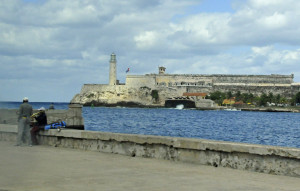Spanish explorers founded Havana in 1519 near a natural harbor on the north side of Cuba. Havana soon became the primary port for shipping goods from the New World back to Spain. When gold ships docked in the port proved sitting ducks for Caribbean pirates, Spanish authorities ordered construction of a large fortress on a hill overlooking the narrow entrance to the harbor. The fortress, completed in about 1640, was named “Castillo de los Tres Reyes Magos del Morro” after the Three Magi. Dubbed “Morro Castle,” the fortress featured an artillery battery called “Twelve Apostles” pointing toward the water. A chain stretching from Morro Castle to the other side of the harbor entrance blocked pirate ships from penetrating the port.
With its port protected by Morro Castle, Havana grew rich providing supplies for vessels heading for Spain. By the middle of the eighteenth century, Havana was the third largest city in the Americas. In 1762, during its Seven Years’ War with France and Spain, England sent 4,000 troops to Cuba and captured Morro Castle by attacking it from the unarmed land side, a tactic that apparently caught the Spanish defenders unprepared. Having lost control of the bustling Havana port, Spain ceded Cuba to England. A year later, England traded Cuba back to Spain in exchange for Florida, a deal many in England thought foolish because of the wealth and importance of Cuba. Florida became England’s fourteenth American colony, but refused to join the other colonies in seeking independence. In 1783, England returned Florida to Spain in the Treaty of Paris ending the American Revolution.
Today, the well-preserved but inadequately signed Morro Castle is open to the public. Every night at precisely 9:00, guards in Spanish colonial uniforms fire a rusty cannon, a ritual originally intended to signal Havana residents the gates of their city were closing. Few Americans hearing the cannon shots know that the unexpected vulnerability of Morro Castle led to an additional, but short-lived, English colony.
